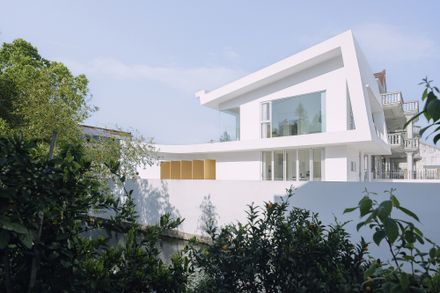ARCHITECTS
Yuanxiuwan Architect & Associates
LEAD ARCHITECT
Xiuwan Yuan
DESIGN TEAM
Xiuwanyuan, Chengxuyin, He Zou
AREA
180 M²
YEAR
2025
LOCATION
Shanghai, China
CATEGORY
Houses
Text description provided by architect.
The project is located in a small village near Hangtoudong Metro Station in Pudong, Shanghai. In the southwest direction, one can see the elevated rail transit in the distance. To the east is a neighboring property, and to the west is a river.
Opposite the riverbank lies a dense forest, with a peninsula site being its characteristic feature. What was shocking during the first visit to the site was not the pastoral scenery, but how the rail transit so dreamily switched between urban and rural areas, as if traveling through time.
The original house, built in the 1980s, was in a dilapidated state, prompting the owner to apply for a reconstruction to provide a more comfortable and peaceful living space for their parents.
According to the approved documents, the main building footprint must be limited to 72.9 square meters (8.1 x 9m), and the auxiliary structure to 30 square meters. The main building is a two-story structure, while the auxiliary space is single-story.
The southern boundary of the main building must not exceed the eastern neighbor's house. The owner, who works in the city, returns to live with their parents on weekends or holidays. Both the parents and the owner require independent bedrooms, while the auxiliary space serves as a study and studio.
SPATIAL DIVISION
The main building, auxiliary building, and the main entrance hall divide the narrow north-south site into six spatial areas of varying density.
The main building and auxiliary structure enclose an inward-facing courtyard, where a twin-trunked boxwood is planted, echoing the trees across the river.
The entrance hall and the auxiliary building form a sunken courtyard at the same level as the road, which also serves as a temporary parking space. The entrance hall, auxiliary space, and main building rise in layers, adopting a humble posture to welcome residents and guests.
A preserved persimmon tree presides over the southern courtyard, bringing new order to the open space.
The central axis of the main building defines public and private zones: the east side houses bedrooms, bathrooms, and a study—quieter, private areas—while the west side, facing the river, accommodates the dining area, staircase, and second-floor living room, opening up to the river as a public zone.
The spatial layout of one entrance, one courtyard, and one alleyway creates a sense of urban depth.
FOLDING
The auxiliary structure and main building enclose the inner courtyard.The sunken courtyard planted with trees is advantageous for water collection and drainage during the rainy season in Shanghai.
The roof of the second floor of the main building tilts inward towards the courtyard at a single slope for optimal light. The end slab turns eastward and rises again, creating a harmonious dialogue with the neighbor's eaves.
The auxiliary building tilts towards the inner courtyard in a curved shape, with water converging from all sides.
The east-west cantilevered roof of the auxiliary building extends southward to form the second-floor slab and continues further to create a balcony then folds back to merge with the roof.
The auxiliary roof, which curves upward to the north, folds down and continues to the south to form the inner courtyard and the first-floor slab of the main building.
The interplay of folds between the roof, slab, and wall creates tension between the primary and secondary, upper and lower, interior and exterior spaces, allowing for multiple narrative possibilities.
SPATIAL NARRATIVE
A narrow, elongated window above the north side of the entrance hall guides the direction of the wind, while a wall-mounted bench below offers a place to pause.
Ascending steps and a riverside outdoor platform draw the gaze forward, where a framed view through the entrance hall unexpectedly captures passing rail transit.
Five wide-open doors facing the river seem to welcome the homeowner, while the twin-trunked boxwood in the courtyard acts as a green guide.
Its left branch pointing to the studio and study in the auxiliary space, and its right branch leading to the living and dining areas in the main building.
Looking out from the living room, the boxwood interacts with sunlight, casting dappled shadows on the east wall, while the curved roof of the auxiliary space gently directs the view toward the northern sky.
Light spills into the living room along the walls, guiding one up the stairs. Through a corner window, looking back towards the entrance, one sees the forest, farmland, and the distant light rail station, bringing the city closer.
The floor-to-ceiling windows of the second-floor living room offer panoramic views of the river and the natural scenery beyond.
The balcony connected to the south bedroom not only provides shade, but its enlarged frame constantly captures the moving scenes of the farmland and the light rail.
The dining area opens up to the river view and extends towards the fields, making the space more rustic and natural.
PATTERN
Cities have a multitude of patterns for living and dwelling, while the countryside is characterized by a singular pattern.
The rumbling light rail passing by seems to traverse these layers of patterns, while this folded box is constructing a pattern of living that is distinct from both the countryside and the city.









































